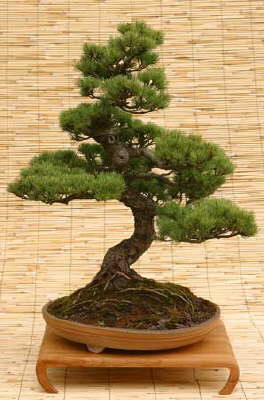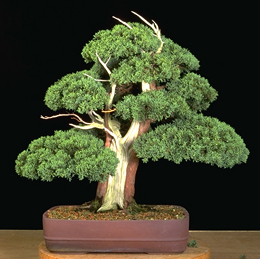 My
Favorite Hobbies
My
Favorite Hobbies My
Favorite Hobbies
My
Favorite Hobbies

|
Far Eastern traditions-including the art of creating bonsai-are appealing to more people in the West. All of these traditions-archery, flower arranging, and landscape painting-are rooted in Zen Buddhism. They are considered "artless arts," meaning that mastering an art consists of going beyond the mere practice of techniques, instead centering one's won involvement on the process.
Those who take up the creation of bonsai and stay with it over a period of time will gain self-awareness, experience time, and in the process gain a sense of happiness.
Indoor Bonsai: Nature or Culture?
The History of Small Trees for the Home
The art of penjing, or miniature landscapes, has been part of Chinese culture since the Tang dynasty (618-906). Its beauty has been passed on in poems and paintings, usually reserved for the noble and the rich. In addition to Zen, the close relationship that existed between people and nature during that time greatly influenced the creation of bonsai. A reverence for simple forms, a sense of the essential, and attention to the harmony found in natureare the basic foundations of bonsai culture-and have remained so to this day.
At this point, let us once and for all, clear up a common misconception of Westerners; that the shapes and forms of miniature trees are due to genetic alteration. That is not true. Time and again, careful observation will reveal that the flowers and fruit of a miniature tree are not significantly smaller than those of a large tree. This means that only the trunk of the tree and its branches are kept small by the skillful tending of the bonsai gardener-something that also takes place in nature because of the influence of climate. The gentic tructure of the plant remains unaltered.
In China, and later also in Japan, the goal was to captures trees in their full beauty and grace and to recreate them as bonsai plants that would be as similar to their big brothers as possible. In China, a bonsai is considered a precious heirloom and is handed down from one generation to another, just as gardening know-how is passed on from father to son to make sure that the art of bonsai will never be forgotten.
 |
Towards the end of Ming dynasty (1368-1644), Buddhist monks (or, according to another legend, a Chinese official) brought bonsai culture to Japan. Like so many other art forms from China, the art of creating bonsai reached new neights in Japan. To this day, Japanese gardeners cultivate small bonsai of unsurpassed beauty and clarity of form. And it was in Japan where the name bonsai, meaning "tree in a tray," was coined. From Japan, this art form began to spread through Europe, however slowly; enthusiasm for and mastery of the art really became widespread only in the last few enturies.
Until the 1970s, these small bonsai trees were grown only outdoors, just like their big brother. In Europe we kept them on balconies, terraces, and patios, and in the garden. It is understandable that indoor bonsai-those liveing inside the house-developed in the Western world, since Westerners generally live more indoors than outdoors. People living in large, modern cities were fascinated with the idea of bringing these small trees and bushes indoors. Formerly they could only be seen from a window or only spend a few hours inside our house, like guests. People longed to be closer to nature and house plants weren't enough anymore. We are sure that the development of indoor bonsai was also inspired by Western myths about trees; with these small trees, people brought the symbol of strength and life into their homes.
How can we understand these trees that grow and thrive inside our homes? They are plants whose life rhythms do not depend on the change of seasons and whose natural climate is similar to that inside our homes. Tropical and subtropical trees and shrubs fulfill these requirements. In their places of origin, temperature and seasonal changes are minimal; vegetation there depends to a very minimal degree on a dormant period, unlike the plants that remain outside in temperate regions in the winter. Particularly in tropical forests, where the climate is warm and humid, a vast number of plants and trees live for hundreds of years. It is from these regions that we find the many species suitable for our wonderful indoor bonsai; rubber trees, bamboo, Schefflera, jacaranda, and many others. Gardenia, azalea, citrus trees, camellia, pomegranate, myrtle, olive, and pine trees, and many other beautiful and very interesting plants, come to us from the subtropical Mediterranean region. All of these plants can be used to create indoor bonsai; of course, they can also be grown outdoors.
Understanding these plants and knowing how to transplant them safely and according to their natural requirements is essential for growing indoor bonsai. Every plant lover and friend of bonsai is aware that in the natural world trees and bushes live outside, so plants kept inside the home need a rest period from time to time in the garden or on the balcony. Of course, in many climates, such "vacations" can only be scheduled during the summer, which is the time that the temperate climate most closely resembles the plants' original habitat.
 Return
to Jenhui Chen's homepage
Return
to Jenhui Chen's homepage